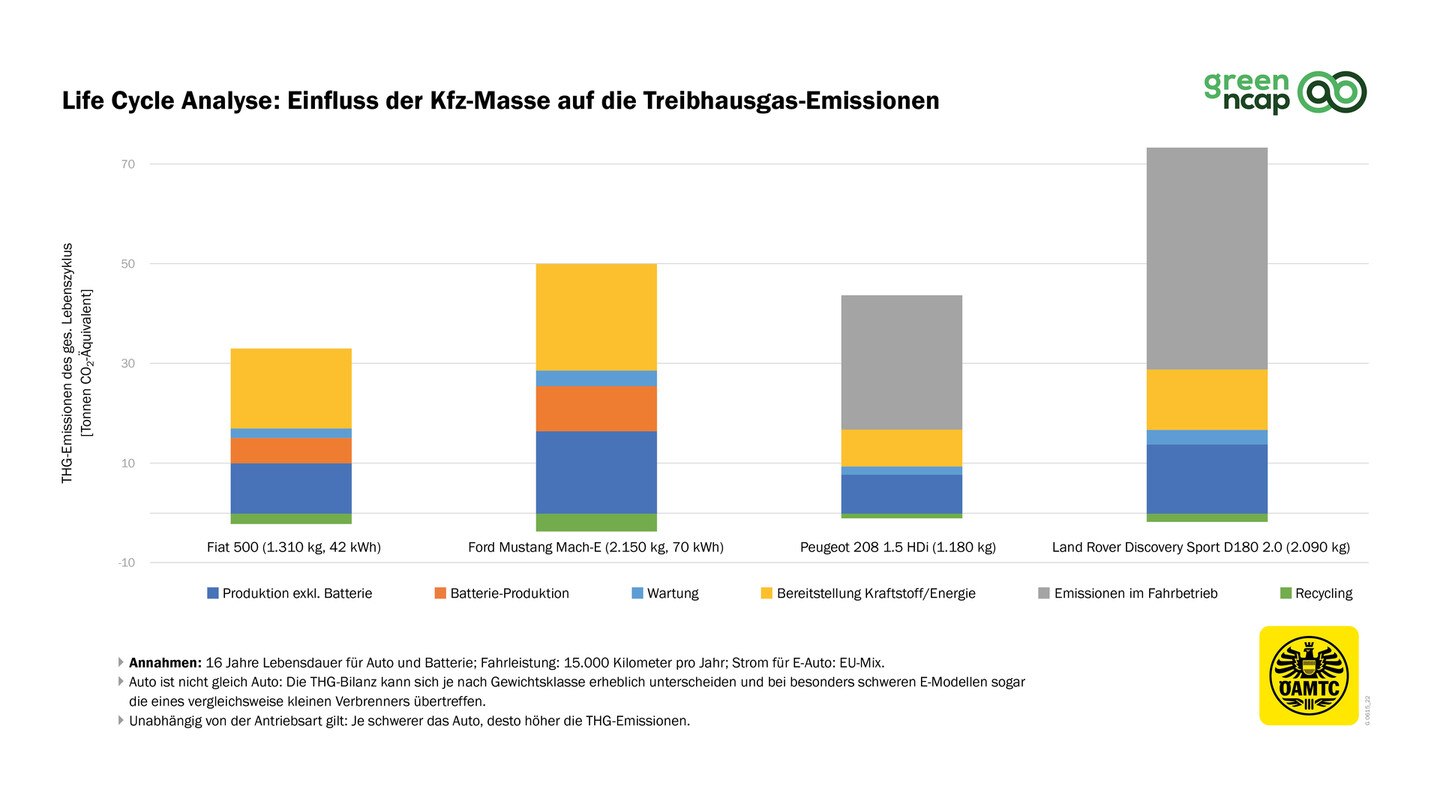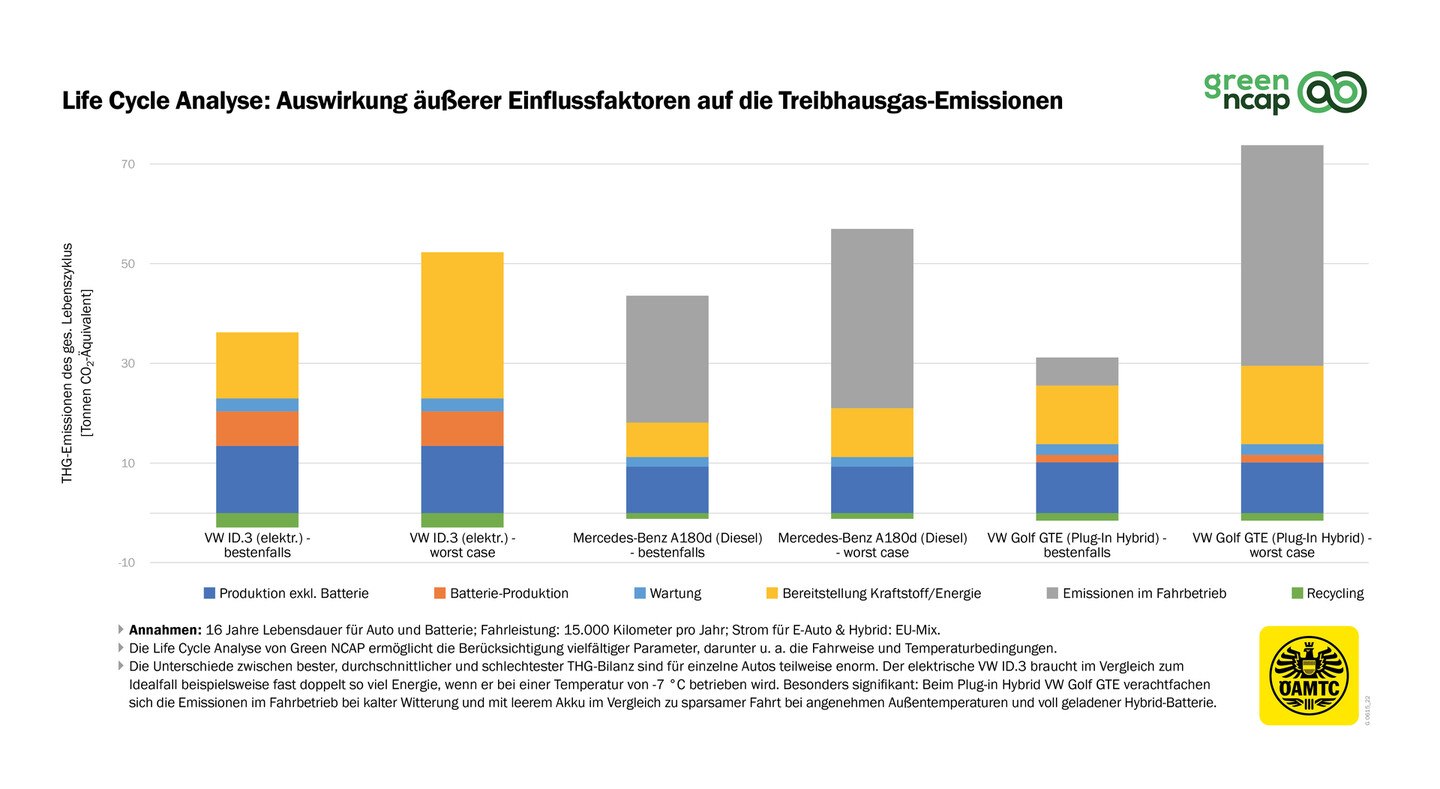ÖAMTC study: This is what the car's eco-balance really looks like
The ÖAMTC and its partner clubs have looked at the actual environmental impact of various cars in detail.

ÖAMTC study: This is what the car's eco-balance really looks like
In 2019, the ÖAMTC and its partner clubs began examining the environmental friendliness of current vehicles as part of the Green NCAP. Since then, over 60 car models have undergone measurements on the chassis dynamometer and on the road and have been tested for emissions of greenhouse gases (GHG) in CO2-equivalent (CO2, N2O, CH4), pollutant emissions and energy consumption of the drive are assessed.
"So far we have examined the vehicles while they are being driven. This will change immediately, because now every car that goes through the Green NCAP measurements will also be subjected to a life cycle analysis," explains Max Lang, vehicle and environmental expert at the ÖAMTC.
“This is an important step in showing the actual greenhouse gas emissions by, for example, also taking into account the generation of the battery in an electric car and the provision of fuel or energy.”
The life cycle analysis requires certain assumptions based on experience. For the present study, for example, 15,000 kilometers per year and a 16-year lifespan were assumed for each car (or the battery in the case of electric vehicles). The ÖAMTC expert Max Lang summarizes the conclusions as follows:
The emissions that a vehicle - regardless of the type of drive - causes during manufacture and operation depend heavily on its mass. In the compact class, for example, this means that the purely electric VW ID.3 produces an average value of 35 tons of CO over its entire life cycle2-equivalent to greenhouse gases, the EU electricity mix is taken as a basis. The places behind in this class are occupied by the plug-in hybrid (Toyota Prius 1.8, approx. 40 tons) as well as the natural gas-powered Seat Ibiza 1.0 TGI and the diesel (Skoda Octavia 2.0 TDI), each with a CO2-Equivalent of approximately 42 tons. Due to their lower consumption, both are still significantly ahead of the petrol engine (BMW 118i, approx. 53 tons).

The greenhouse gas emissions that an electric car causes over the course of its existence also depend on how the electricity used for charging is generated. The example of the VW ID.3 shows that this vehicle produces around 35 tons of CO in the current EU electricity mix2-Equivalent caused - around 15 tonnes of this is due to charging. If Austrian electricity alone could be used for charging, the greenhouse gas emissions needed to provide the energy would be reduced to around 10 tons. However, this is not easily possible because you always get the electricity generated throughout the EU from the general network. One way to prevent this is to charge via a private or public PV system that is not connected to the general grid.
The differences can also be large within the drive types: electric heavyweights like the Ford Mustang Mach-E cause more CO over the course of the car's life2-Equivalent to some compact class diesel engines. This applies to all drives: the less mass, the fewer greenhouse gases. Large combustion engines are particularly bad for the balance sheet, for example the Land Rover Discovery Sport D180, which clearly overshadows the Mustang Mach-E in terms of greenhouse gas emissions despite its slightly lower mass.

External factors such as driving style and weather conditions sometimes have a strong influence on greenhouse gas emissions. Here, too, there are differences between the drive types: While with a combustion engine it makes a comparatively small difference how cold or warm the ambient temperature is, an electric car can need twice as much energy if the temperature falls below freezing point. The differences are particularly significant with the plug-in hybrid: With the VW Golf GTE, for example, emissions increase eightfold when driving in cold weather and with an empty battery compared to driving economically in pleasant outside temperatures and a fully charged hybrid battery.

For the ÖAMTC expert it is clear that e-mobility is an important part of reducing greenhouse gas emissions from road transport. "The life cycle analysis confirms that electric cars can be operated in a very environmentally friendly manner. That's positive - but you shouldn't ignore the fact that a completely CO2-neutral operation is not as easy as one would like under the current conditions,” explains Lang.
"From our point of view, two things have to happen with regard to the operation of electric cars: Electricity has to become greener, not just in Austria, but across the EU. And it must be clear that electric vehicles also have a massive environmental disadvantage, the larger they are."
However, the life cycle analysis also clearly shows that combustion engines - if you look at the entire life cycle of a vehicle based on the current EU electricity mix - are not as far behind electric cars as one might assume. "If combustion engines were operated with alternative, biogenic fuels generated with green electricity, the race would be much closer. From the mobility club's point of view, the solution to achieving the climate goals in a timely manner can therefore only continue to be openness to different technologies," the ÖAMTC expert concludes.

 Suche
Suche
 Mein Konto
Mein Konto